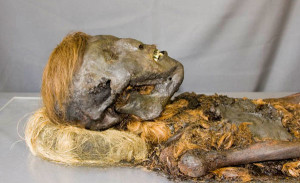 As reported in several news outlet as well as the Siberian Times, a team of archeologists have uncovered mummies which are believed to have connections to ancient Persia. Archaeologists have resumed excavations at Zeleniy Yar, a remote site near the Arctic Circle known to the indigenous Nenets people as “the end of the earth”. In a previous excavation, the team had found a dozen mysterious mummies who appear to have been foreign to the region, and whose artifacts can be traced back to ancient Persia, nearly 6,000 kilometres (3,700 miles) away. For now, scientists are undertaking genetic testing to determine the actual origins of the mummies.
As reported in several news outlet as well as the Siberian Times, a team of archeologists have uncovered mummies which are believed to have connections to ancient Persia. Archaeologists have resumed excavations at Zeleniy Yar, a remote site near the Arctic Circle known to the indigenous Nenets people as “the end of the earth”. In a previous excavation, the team had found a dozen mysterious mummies who appear to have been foreign to the region, and whose artifacts can be traced back to ancient Persia, nearly 6,000 kilometres (3,700 miles) away. For now, scientists are undertaking genetic testing to determine the actual origins of the mummies.
About a decade ago another team of Russian archaeologists discovered 34 shallow graves and mummified corpses in what appears to be a necropolis dating back 800 years. However, excavations stopped after the local people expressed concerns that the work was disturbing the souls of their ancestors, a plea which has been ignored by the current team of researchers, headed by Alexander Pilipenko, research fellow of Institute of Cytology and Genetics, part of the Siberian Branch of the Russian Academy of Sciences.
The finding was extremely rare as the team explains that the mummies were found in a well-preserved state, seemingly by accident, and wearing copper masks. Seven male adults, three male infants, and one female child were discovered, buried among jewelry and other artifacts. Their skulls are shattered or missing, while the skeletons were smashed. Five mummies are covered in copper, as well as reindeer, beaver, wolverine, or bear fur. One of the mummies is a red-haired male, protected from chest to foot by copper plating. In his resting place, were an iron hatchet, furs, and a head buckle made of bronze depicting a bear.
Researchers believe that the mummification of the bodies was not intentional but was caused by a combination of the copper, which prevented oxidation of the remains, and a drastic change in temperatures in the centuries after the group was buried. The scientists also believe that the condition and orientation of the remains reflect some type of religious ritual. However, such burial rituals are unknown to experts and not typical of others in the region, which suggests that the mummies belong to a foreign race of people. Indeed, the artifacts suggest this possibility. Some of the items found at the site, including bronze bowls, originated in Persia and dating from the 10th or 11th centuries. The discovery adds to the evidence that Siberia was not an isolated wasteland but a crossroads of international trade and cultural diversity.















